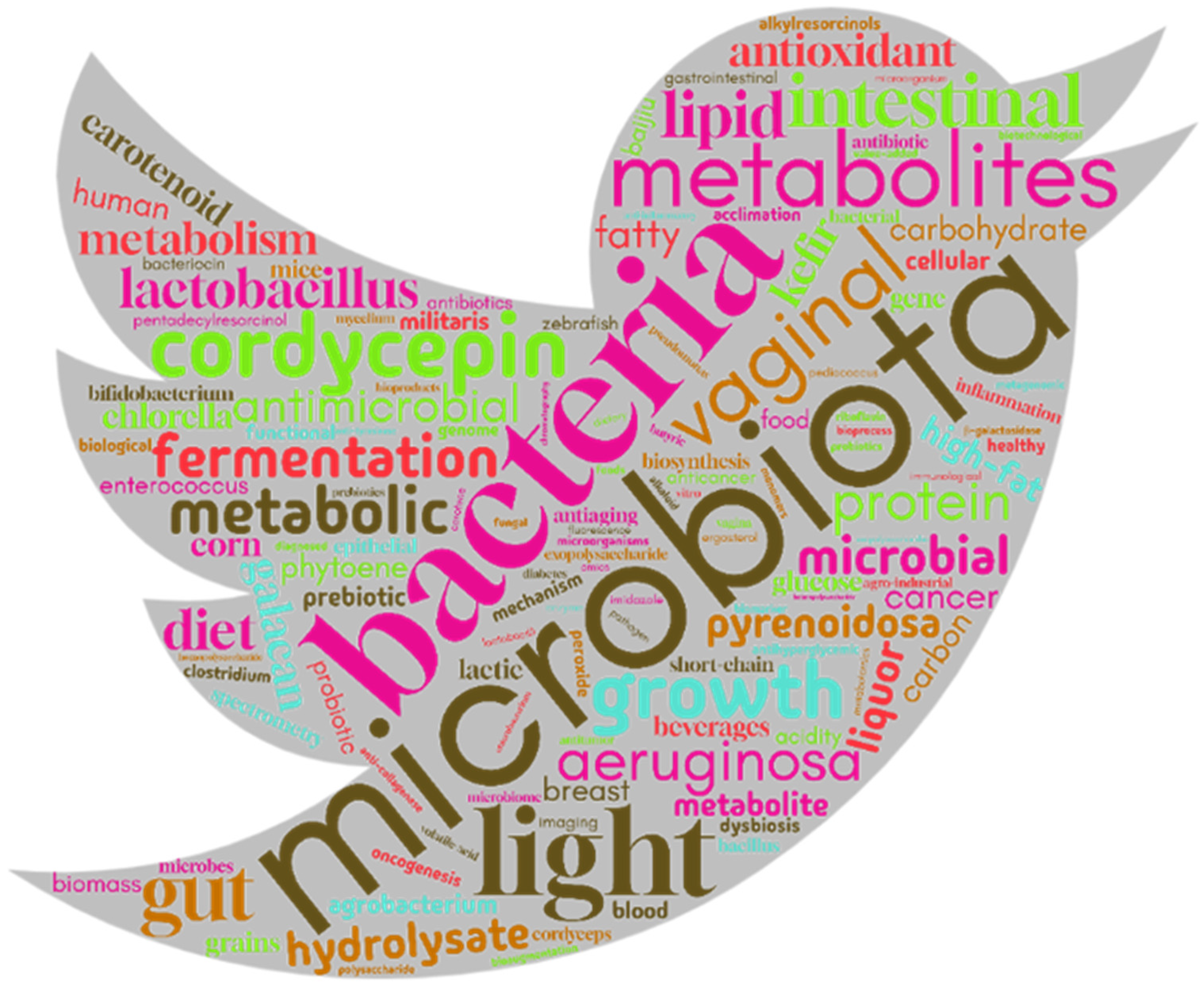Microbes and Their Products for Sustainable Human Life
Author Contributions
Funding
Acknowledgments
Conflicts of Interest
List of Contributions
- Sharma, R.; Garg, P.; Kumar, P.; Bhatia, S.K.; Kulshrestha, S. Microbial Fermentation and Its Role in Quality Improvement of Fermented Foods. Fermentation 2020, 6, 106.
- Rani, A.; Saini, K.C.; Bast, F.; Mehariya, S.; Bhatia, S.K.; Lavecchia, R.; Zuorro, A. Microorganisms: A Potential Source of Bioactive Molecules for Antioxidant Applications. Molecules 2021, 26, 1142.
- Karirat, T.; Saengha, W.; Sutthi, N.; Chottanom, P.; Deeseenthum, S.; Ma, N.L.; Luang-In, V. Valorization of Riceberry Broken Rice and Soybean Meal for Optimized Production of Multifunctional Exopolysaccharide by Bacillus tequilensis PS21 with Potent Bioactivities Using Response Surface Methodology. Polymers 2025, 17, 2029.
- Li, D.; Ye, G.; Zong, X.; Zou, W. Effect of Multiple Rounds of Enrichment on Metabolite Accumulation and Microbiota Composition of Pit Mud for Baijiu Fermentation. Foods 2023, 12, 1594.
- Chang, Y.; Liu, X.; Jiao, Y.; Zheng, X. Improved Cordycepin Production by Cordyceps Militaris Using Corn Steep Liquor Hydrolysate as an Alternative Protein Nitrogen Source. Foods 2024, 13, 813.
- de Carvalho Alves, J.; de Souza, C.O.; de Matos Santos, L.; Viana, S.N.A.; de Jesus Assis, D.; Tavares, P.P.L.G.; Requião, E.d.R.; Ferro, J.M.R.B.d.S.; Roselino, M.N. Licuri Kernel (Syagrus coronata (Martius) Beccari): A Promising Matrix for the Development of Fermented Plant-Based Kefir Beverages. Foods 2024, 13, 2056.
- Xu, X.; Du, L.; Wang, M.; Zhang, R.; Shan, J.; Qiao, Y.; Peng, Q.; Shi, B. Antihyperglycemic, Antiaging, and L. brevis Growth-Promoting Activities of an Exopolysaccharide from Agrobacterium sp. FN01 (Galacan) Evaluated in a Zebrafish (Danio rerio) Model. Foods 2024, 13, 2729.
- Huang, X.; Lin, R.; Mao, B.; Tang, X.; Zhao, J.; Zhang, Q.; Cui, S. Lactobacillus crispatus CCFM1339 Inhibits Vaginal Epithelial Barrier Injury Induced by Gardnerella vaginalis in Mice. Biomolecules 2024, 14, 240.
- Yin, Z.; Zhu, L.; Gao, M.; Yu, D.; Zhang, Z.; Zhu, L.; Zhan, X. Effects of In Vitro Fermentation of Polysialic Acid and Sialic Acid on Gut Microbial Community Composition and Metabolites in Healthy Humans. Foods 2024, 13, 481.
- AlDawsari, M.; Al-Ansari, M.M.; AlMalki, R.H.; Rahman, A.M.A.; Al-Alwan, M. The MDA-MB-231 Breast Cancer Cell Secretomes Modify Metabolomes of Pseudomonas aeruginosa Breast Microbiome. Int. J. Mol. Sci. 2025, 26, 5003.
- Zabolotneva, A.A.; Vasiliev, I.Y.; Grigoryeva, T.; Gaponov, A.M.; Chekhonin, V.P.; Roumiantsev, S.A.; Shestopalov, A.V. Supplementation of a High-Fat Diet with Pentadecyl resorcinol Increases the Representation of Akkermansia muciniphila in the Mouse Small and Large Intestines and May Protect against Complications Caused by Imbalanced Nutrition. Int. J. Mol. Sci. 2024, 25, 6611.
- Yao, X.; Nie, W.; Chen, X.; Zhang, J.; Wei, J.; Qiu, Y.; Liu, K.; Shao, D.; Liu, H.; Ma, Z.; et al. Two Enterococcus faecium Isolates Demonstrated Modulating Effects on the Dysbiosis of Mice Gut Microbiota Induced by Antibiotic Treatment. Int. J. Mol. Sci. 2024, 25, 5405.
- Mantzouridou, F.T.; Sferopoulou, E.; Thanou, P. Uncovering the Hidden Potential of Phytoene Production by the Fungus Blakeslea trispora. Foods 2024, 13, 2882.
- Qiao, Y.; Tian, F.; Yu, L.; Zhao, J.; Zhai, Q.; Chen, W. Imaging Mass Spectrometry and Genome Mining Reveal Antimicrobial Peptides of Novel Pediococcus acidilactici CCFM18. Foods 2024, 13, 2213.
- Zhu, T.; Guan, G.; Huang, L.; Wen, L.; Li, L.; Ren, M. Transcriptomic and Metabolomic Analysis Reveal the Effects of Light Quality on the Growth and Lipid Biosynthesis in Chlorella pyrenoidosa. Biomolecules 2024, 14, 1144.

Disclaimer/Publisher’s Note: The statements, opinions and data contained in all publications are solely those of the individual author(s) and contributor(s) and not of MDPI and/or the editor(s). MDPI and/or the editor(s) disclaim responsibility for any injury to people or property resulting from any ideas, methods, instructions or products referred to in the content. |
© 2025 by the authors. Licensee MDPI, Basel, Switzerland. This article is an open access article distributed under the terms and conditions of the Creative Commons Attribution (CC BY) license (https://creativecommons.org/licenses/by/4.0/).
Share and Cite
Gurav, R.; Bhatia, S.K. Microbes and Their Products for Sustainable Human Life. Biomolecules 2025, 15, 1168. https://doi.org/10.3390/biom15081168
Gurav R, Bhatia SK. Microbes and Their Products for Sustainable Human Life. Biomolecules. 2025; 15(8):1168. https://doi.org/10.3390/biom15081168
Chicago/Turabian StyleGurav, Ranjit, and Shashi Kant Bhatia. 2025. "Microbes and Their Products for Sustainable Human Life" Biomolecules 15, no. 8: 1168. https://doi.org/10.3390/biom15081168
APA StyleGurav, R., & Bhatia, S. K. (2025). Microbes and Their Products for Sustainable Human Life. Biomolecules, 15(8), 1168. https://doi.org/10.3390/biom15081168





